Final report for ONE16-272
Project Information
This project builds on previous work that had showed that hairy vetch and red clover could improve hay field production using no-till methods. The goal of the project was to increase the profitability of grass-based farming operations by identifying combinations of legumes and grasses that could be established by no till seeding to increase yields on pasture and hayfields. Six farmers collaborated by allowing us to seed six plots on each farm (one farmer had us create two sets of six plots). Five combinations of legumes and grasses were trialed on each farm. Combinations trialed were Birdsfoot Tefoil and Perennial Rye Grass, Red Clover with White Clover, Hairy Vetch, and White Clover With Kentucky Bluegrass. Farms were checked for numbers of germinating plants and one year later forage samples were taken of each seeding on each farm and compared to a control from that farm. The grain drill resulted in quicker germination in dry conditions, but the spun on seed ultimately germinated also.
Forage samples of the controls and seedings were taken for all farms in June of 2017. Overall the pattern of improvements was modest but noticeable. Increase in crude protein occurred on 5 out of 6 farms for perennial ryegrass with birdsfoot trefoil, red clover with white clover, hairy vetch, red clover with oarchard grass. Only Kentucky bluegrass and White Clover treatment failed to improve crude protein on 5 out of 6 farms. Strongest improvements were in Perennial Ryegrass (3.45%) and trefoil and Red and white clover (3.4%)
Improvement in aNDF (lowering of fiber content) was noted on 5 out of 6 farms for all treatments except hairy vetch, which improved aNDF on 4 out of 6 farms. Again the largest improvements were with birdsfoot trefoil and perennial ryegrass (-7.5%) and red and white clover (-3.5%)
Improvements for net energy lactation megacalories per pound were not as strong with only half of the farms in most treatments showing improvement.
From the results of the forage analysis. It appears that no-till reseeding does produce measurable improvements in forage quality, with the combinations of perennial rye grass with birdsfoot trefoil and red and white clover showing the greatest improvements.
Based on this trial our recommendation is that farmers interested in no-till reseeding are likely to be successful using a cocktail of seeds that includes red and white clover, birdsfoot trefoil, perennial rye grass and orchard grass.
Perennial ryegrass, orchard grass birdsfoot trefoil, red clover, and white clover all showed promise in this trial. Future testing evaluating a mixes of these seeds at different seed rates would help let farmers know what the optimal seed rates are and if heavier seedings improve forage quality in no-till re-seedings.
Fourteen farmers reporting learning from the results of this study and six farmers are adopting this practice in some form.
Outreach was completed in the form of articles in farming periodicals, summary in the Cornell Small Farms program website, http://smallfarms.cornell.edu/2018/04/06/low-cost-seeding-methods-for-improving-pastures-and%e2%80%afhaylands%e2%80%af-in-progress/ and in a short video, https://youtu.be/xtV8QX0yEPk, attached below.
The question we wish to answer is; what are the best combinations of legumes and grasses for organic no-till reseeding
to increase the yields of under-producing pastures and hayfields in locations that are too costly or too
risky to re-seed using conventional methods.
Our objectives are to compare combinations of seedings of hairy vetch, red clover, white clover, birdsfoot trefoil,
annual ryegrass, Kentucky bluegrass, orchard grass, and other grasses to determine which combinations are
most effective at becoming established and improving yields in the short and long-term.
To accomplish this are activities planned:
- Six farms to have plots laid out for trial in 2016
- All plots to be tested for pH in spring of 2016
- All farms to be brought up to 6.0 or above pH by liming 4based on pH test results
- Trial seed combinations identified and uniformly mixed for all plots
- Seed to be applied to all plots on all six farms in spring of 2016
- Growth to be measured of all trial combinations on all six farms
- Evaluation of combinations of seeding methods and seeding mixes to be carried out in 2016 and 2017
SARE grant funded studies in New Hampshire had suggested that hairy vetch could be successfully no-till re-seeded to improve forage qualitiy for farmers. SARE grant funded studies in Maine showed that red clover could be no-till seeded to improve hay quality. Our goal was to investigate how hairy vetch and red clover and other legumes and grasses compared when it came to no-till re-seeding.
Our project builds on SARE projects carried out in a 1994 study by John Mill Bocker in Johannesburg Michigan, work carried out in Gabe Clark in North New Portland Maine in 2009, and by Dorn Cox in Lee, New Hampshire. The project is also based on informal studies at Merck Forest and Farmland Center in Rupert, Vermont from 2005 to 2007, a small pilot study carried out in 2015 by Cooperative Extension of Chenango County. The work builds on the work of Dorm Cox in the 2012 study into the growth of hairy vetch no-till seeded on sod with supplements of wood ash. Our study is done without wood ash, and is done on a farm scale rather than on test plots. The similarities are that the Cox studies shows that hairy vetch can, under some conditions, can be successfully no-tilled into sod to improve productivity. We intend to more fully explore the possibilities of hairy vetch for this purpose. We have reason to believe that hairy vetch has more potential for no-till sod improvement than was shown by the Cox study because of informal research done at Merck Forest and Farmland Center from 2005 to 2007, where hairy vetch was successfully no-drilled into existing hayfields increasing yields in the following years. Our work will also build on the work of John Milbocker in 1994, where he demonstrated that red clover could be successfully no-till seeded into existing sod sufficiently to increase the carrying capacity of the pasture. It also shows that seeding can be successful without additional supplementation of Phosphorus. Our work goes beyond his very important study by doing more replications across different farms and by quantifying and comparing different combinations of legumes and grasses. Our work also expands on the work of Gabe Clark in Maine where he found that alfalfa, red clovers and grasses could be successfully no-tilled into existing pastures and hay fields to increase yields. Our study expands his work by including other species and by providing a different measurement technique to allow better comparisons between the different treatments. In conclusion, work by others with red clover, hairy vetch and grasses show that they can be successfully no-tilled to improve pasture and hay fields. Our work builds on the earlier work by providing more varied comparisons of lands and seed combinations for analysis, more thoroughly quantifying results, and by more widely disseminating results through online video.
Cooperators
Research
Trial Location
Six dairy farms in Chenango County participated in the project. Two conventional small dairy farms; one milking 40 cows and the other milking 90 cows. The other four farms were newly established farms of New Order Amish families, which started farming in 2015 and 2016. Their herd sizes were 40-45 cows on each farm. These four Amish farms are all certified organic. The goals and methods of the project were explained to the farmers prior to applying for the 2015 grant and again prior to beginning seeding in spring of 2016 .
Seeding Plots and Combinations Trialed
Five different seeding combinations of grasses and legumes, were replicated on each farm. Each farm had a total of six one acre test plots, one acre each for the five seeding treatments and one acre as a control. To ensure that all soil plots had pH of 6.0 or higher, soil samples from each farm’s test plots were gathered and analyzed for pH by the Dairy One Labs of Ithaca, NY. Four the farms test plots were found in need of lime to get the soil pH levels to 6.0 these farms were The Schmidt, Troyer, Ruben Miller, and Hershberger farms needed lime. The Kemmeren and Leroy Miller farms had pH levels over 6.0 and needed no additional lime. Lime was purchased and spread at the rate recommended by Dairy one to achieve pH of 6.0
The following seeding combinations were trialed in one acre plots on each of the six farms:
Plot 1: No seeds, control
Plot 2: Perennial Ryegrass 8.3 pounds, Birdsfoot Trefoil, 8.3 pds.
Plot 3: White Clover, 4.1 pds, Red Clover 8.3pds.
Plot 4: Hairy Vetch 33 pds.
Plot 5: Red Clover 8.3 pds Orchard Grass 4.1 pds.
Plot 6: White Clover 4.1 pds, Bluegrass 4.1 pds, Orchard Grass 4.1 Pds.
After the purchase of the seeds Rich Taber worked with project participant John Kemmeren to measure, mix, bag and label the seed combinations for all the farm’s plots to ensure proper mixing combinations.
Rich Taber went to each farm and physically measured and laid out the six, one acre plots with each farmer.
Prior to seeding, five of the farms grazed the seeding plots with either dairy cows, heifers, or draft horses ahead in order to remove as much of the existing vegetation as possible. The Kemmeren’s applied glyphosate to their test plots in the fall of 2015. Though this was a trial for organic approaches, we felt that having a glyphosate treated plots in the trial provided a beneficial comparison. The seeding were done in the month of May.
Each farm was responsible for deciding how to seed the mixes. The different farms used the following methods of seeding:
- Farm 1, Conventional Dairy, (Schmidt) used an older no-till seeder. The plots were grazed immediately prior seeding.
- Farm 2, Conventional Dairy, (Kemmeren) used a modern, multi-row no-till drill manufactured by Great Plains. The plots were treated with glyphosate the fall before seeding.
- Farm 3, Organic, (Troyer) used a broadcast spinning seeder. The plots were grazed immediately prior seeding.
- Farm 4, Organic, (Hershberger) used the Kemmeren no-till seeder. The plots were grazed immediately prior seeding.
- Farm 5, Organic, (Rubin Miller), used the Kemmeren no-till seeder. The plots were grazed immediately prior seeding.
- Farm 6, Organic, (Leroy Miller), used a broadcast seeder. The plots were grazed immediately prior seeding.
2016 activities
- Trial Plots were successfully laid out on 6 farms
- All plots were tested for pH in spring of 2016
- All farms were brought up to 6.0 or above pH by liming 4 farms based on pH test results
- Seed combinations were uniformly mixed for all plots
- Seed was applied to all plots on all six farms in spring of 2016
- Growth was measured of all trial combinations on all six farms
- Some combinations of seeding methods and seeding mixes were found to be successfully no-tilled.
2017 activities
- All plots on all farms were visited, photographed and forage samples were taken
- Forage Samples were shipped to Dairy One Forage Lab
- Results for Forage samples were entered into a spread sheet for analysis
- Forage sample analysis was reviewed by collaborators Karen Hoffman USDA Grazing Specialist, David Balbian Dairy Specialist for the Cornell Central New York Dairy and Field Crops Team and Kevin Ganoe Field Crop Specialist for the Cornell Centrall New York Dairy and Field Crops Team
- Essential message of the project distilled from Kevin Ganoe, Karen Hoffman and Dave Balbian was that though there was variation by farm, in nearly all cases forage quality was improved by no-till seedling.
2018 activities
- Writing "Better Hay and Pasture Now" article for Country Folks
- Writing "Low Cost Seeding Methods forImproving Pasture and Haylands" for Cornell Small Farm Journal
- Publishing "Low Cost Seeding Methods forImproving Pasture and Haylands" on Cornell Extension Website; http://smallfarms.cornell.edu/2018/04/06/low-cost-seeding-methods-for-improving-pastures-and%e2%80%afhaylands%e2%80%af-in-progress/
- Creation of short video announcing results of no-till seeding study.
Seeding Results
The two month period of May and June during and after seeding were extremely dry with less than one inch of rain during the entire time span. The dry conditions adversely affected conditions for germination. On farm inspections were done several times soon after seeding and noted little to no growth was found, regardless of seeding method. In July there was modest rainfall fell and some growth of new seedlings occurred. Once seed growth was noted, further inspections and plant counts for numbers of seedlings on each plot on each farm occurred. Seeding counts were made on 3 foot by 3 foot sub plots.
After measuring growth on the test plots, the farmers were allowed the farmers to graze the plots with their livestock, or harvest plots with equipment.
The three farms (Kemmeren, Rubin Miller, and Hersberger) that used the modern no-till drill had were the only ones with successful seedings. The two farms that spun seed on to the soil surface had no visible growth of new seeds. Also the one farm (Schmidt that used the older no-till seeder, had no visible growth of new seed)
On the three farms that has been seeded with the no till drill the following combinations of seeding showed success:
- Hershberger farm: Red clover/White clover, Hairy vetch, and Red clover/Orchard grass.
- Kemmeren farms:, Red clover/White clover, Hairy vetch, Red clover/orchard grass.
- Ruben Miller farm: Red clover/White clover, Red clover/Orchard grass
Forage Analysis Results
Forage from all plots on all 6 farms were sampled in June of 2017 and tested at Dairy One Forage analysis in Ithaca, New York. Based on recommendations from collaborator Dave Balbian, Dairy Specialist for the Central New York Dairy and Field Crop Team, we selected three items from the forage analysis tests for comparison. Crude Protein, aNDF (amylase neutral detergent fiber), and NEL Mcal/lb (Net Energy Lacation in megacalories per pound).
We expected a great deal of variation because we were reviewing 6 different farms with different control plots, different planting method, and different weather and soils, but we hoped some general patterns would appear. The following is a narrative of the results for those components for each sample
Birdsfoot Treefoil and Perennial Rye (plot 2 on all farms)
Crude Protein (higher values indicate better forage quality)
This seed combination increased crude protein on 5 out of 6 farms. The maximum increase was 8.5 percent on one farm and the low was minus .09% on another farm. The average increase in crude protein was 3.45%.
aNDF (lower values indicate better forage quality/improved digestibility)
aNDF was reduced on 5 out of 6 farms. The range was from -13.8 % to + 2.2 % average reduction compared to control was -5.5 %.
Net Energy Lactation (higher values indicate better forage quality)
Net Energy Lactation was improved on 4 out of 6 farms the range was from .17 Mcals/lb a 37% increase compared to the control sample to 0 additional Mcals . Average change in Mcals was +7.2%
Red Clover and Whiter Clover
Crude Protein (higher values indicate better forage quality)
This seed combination increased crude protein on 5 out of 6 farms. The maximum increase was 7.8 percent on one farm and the low was minus -6.4 on another farm. The average increase in crude protein was 3.4%.
aNDF (lower values indicate better forage quality/improved digestibility)
aNDF was reduced on 5 out of 6 farms. The range was from -14.7 % to + 1.6 % average reduction compared to control was -7.5 %.
Net Energy Lactation (higher values indicate better forage quality)
Net Energy Lactation was improved on 5 out of 6 farms the range was from .12 Mcals/lb a 37% increase compared to the control sample to -.09 Mcal/lb a 14% reduction . Average change in Mcals was +12.8%
Hairy Vetch
Crude Protein (higher values indicate better forage quality)
This seed combination increased crude protein on 5 out of 6 farms. The maximum increase was 6.5 percent on one farm and the low was minus -7.5 on another farm. The average increase in crude protein was 2.3%.
aNDF (lower values indicate better forage quality/improved digestibility)
aNDF was reduced on 4 out of 6 farms. The range was from -20.4 % to + 3.9 %. Average reduction compared to control was -7.5 %.
Net Energy Lactation (higher values indicate better forage quality)
Net Energy Lactation was improved on 3 out of 6 farms the range was from .13 Mcals/lb a 23% increase compared to the control sample, to -.1 Mcal/lb a 16% reduction . Average change in Mcals was +3.1%
Red Clover with Orchard Grass
Crude Protein (higher values indicate better forage quality)
This seed combination increased crude protein on 5 out of 6 farms. The maximum increase was 6.4 % on one farm and the low was minus – 6.2% on another farm. The average increase in crude protein was 2.1%.
aNDF (lower values indicate better forage quality/improved digestibility)
aNDF was reduced on 5 out of 6 farms. The range was from -10.7 % to + 6.6 %. Average reduction compared to control was -2.6 %.
Net Energy Lactation (higher values indicate better forage quality)
Net Energy Lactation was improved on 4 out of 6 farms the range was from .1 Mcals/lb a 24.5% increase compared to the control sample, to -.09 Mcal/lb a 14.5% reduction versus the control . Average change in Mcals was +5.0%
Kentucky Blue grass, White Clover, Orchard Grass
Crude Protein (higher values indicate better forage quality)
This seed combination increased crude protein on 3 out of 6 farms. The maximum increase was 7 % on one farm and the low was minus – 8.3% on another farm. The average increase in crude protein was 1.0%.
aNDF (lower values indicate better forage quality/improved digestibility)
aNDF was reduced on 5 out of 6 farms. The range was from -10.7 % to + 6.6 %. Average reduction compared to control was -1.2 %.
Net Energy Lactation (higher values indicate better forage quality)
Net Energy Lactation was improved on 4 out of 6 farms the range was from .04 Mcals/lb a 8.7% increase compared to the control sample, to -.07 Mcal/lb a 11.3% reduction versus the control . Average change in Mcals was -1.2%
Discussion:
Overall the pattern of improvements was modest but noticeable. Increase in crude protein occurred on 5 out of 6 farms for perennial ryegrass with birdsfoot trefoil, red clover with white clover, hairy vetch, red clover with oarchard grass. Only Kentucky bluegrass and White Clover treatment failed to improve crude protein on 5 out of 6 farms. Strongest improvements were in Perennial Ryegrass (3.45%) and trefoil and Red and white clover (3.4%)
Improvement in aNDF (lowering of fiber content) was noted on 5 out of 6 farms for all treatments except hairy vetch, which improved aNDF on 4 out of 6 farms. Again the largest improvements were with birdsfoot trefoil and perennial ryegrass (-7.5%) and red and white clover (-3.5%)
Improvementsf for net energy lactation megacalories per pound were not as strong with only half of the farms in most treatments showing improvement.
From the results of the forage analysis. It appears that no-till reseeding does produce measurable improvements in forage quality, with the combinations of perennial rye grass with birdsfoot trefoil and red and white clover showing the greatest improvements.
Initial Conclusions:
In years of extreme dryness such as 2016, a modern no-till seeder seems to provide a significant advantage in establishing seedings. It appears that seeding combinations of Red clover/White clover, Red Clover/Orchard grass, and Hairy Vetch are better able to establish under no-till conditions than a Perennial Ryegrass and Birdsfoot Trefoil mix , or White clover, Kentucky Bluegrass, Orchard grass mix.
Our results showed that farmers can use a lower cost no-till re-seeding of a mix of legumes and perennial rye grass or orchard grass to improve their pastures and hayfields. This could increase farm profitability on farms that rely on upland fields to produce forage for sale or for livestock.
Recommendations:
based on this trial our recommendation is that farmers interested in no-till reseeding are likely to be successful using a cocktail of seeds that includes red and white clover, birdsfoot trefoil, perennial rye grass and orchard grass.
Suggestions for further Study:
Perennial ryegrass, orchard grass birdsfoot trefoil, red clover, and white clover all showed promise in this trial. Future testing evaluating a mixes of these seeds at different seed rates would help let farmers know what the optimal seed rates are and if heavier seedings improve forage quality in no-till re-seedings.
Education & Outreach Activities and Participation Summary
Participation Summary:
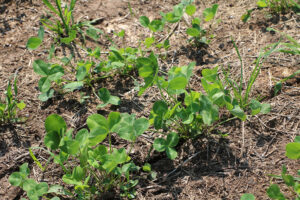
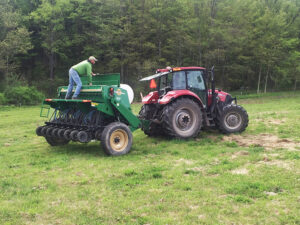
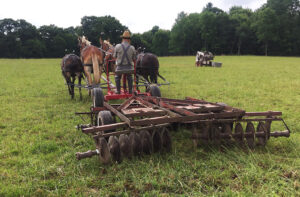
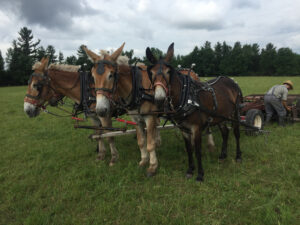
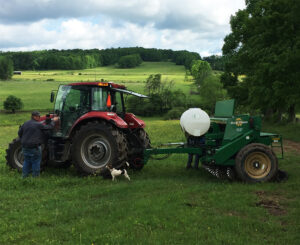
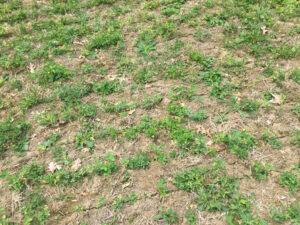
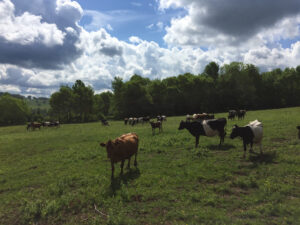
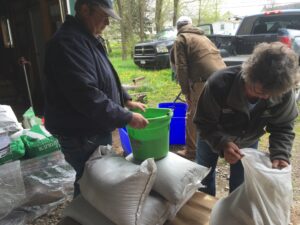
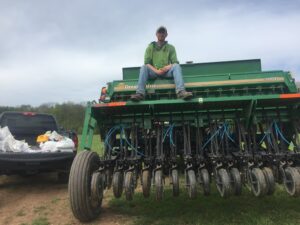
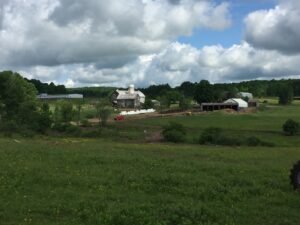
Fall 2016 Cornell Cooperative Extension Chenango held a workshop that provided photos and information based on the no-till trial that we had started in 2016
Spring 2018 Country Folks Article "Better Hay and Pasture Now, No Need to Plow" by Ken Smith, describing the need for low-cost methods for improving hayfields and pasture and describing the trial and outcomes and making recommendations.
Spring 2018 Cornell Small Farmers Journal article "Low Cost Seeding Methods for Improving Pasture and Haylands" by Richard Taberdescribing the need for low-cost methods for improving hayfields and pasture and describing the trial and outcomes and making recommendations.
May-June 2018 Cornell Cooperative Extension of Chenango County Extension Express article "Low Cost Seeding Methods for Improving Pasture and Haylands" by Richard Taber and Ken Smith describing the need for low-cost methods for improving hayfields and pasture and describing the trial and outcomes and making recommendations.
Summer 2018 YouTube and Facebook Video "SARE No-Till Re-Seeding Trial" https://youtu.be/xtV8QX0yEPk
Learning Outcomes
The main point of the trial was to show that no-till seeding could be effective. The farmers directly involved reported that knowing that no-till seeding could effective would encourage them to try it on more fields. Though we have done other outreach, the articles and videos have not created direct responses to us.
SARE Final Farmer Interviews Sept. 2018
We asked the farmers the following questions:
Have you adopted any practices for your future seeding endeavors from this study, and what have you learned?
Mark Schmidt: Mark is a conventional farmer, but is almost organic in his forage practices, using no pesticides. He states the following:
I had problems with the no till seeder in 2016, not knowing how to calibrate it correctly, and the seeding was very poor as a result. This summer of 2018 I contracted for a farmer with a modern era no till drill to seed the same plots that were seeded in 2016, and the results have been promising so far. I will continue to embrace the use of a no till drill, and graze the plots heavily with cows before seeding in the future, and make sure that soil ph and fertility levels are up to par. Mark farms with conventional farm machinery.
Reuben Miller: His plots were seeded with a no till drill and he was pleased with the results. He leans towards using full tillage for future plots but is amenable to drilling for reseeding existing pastures that need improvement, and by preparing them with heavy grazing and maintenance of pH and fertility levels. Reuben farms with advanced draft horse technology and uses four Belgian-mule crosses for power, along with a power forecart with engine for powering his machinery. His only concern is finding an available no till drill during the spring months.
Jon Hershberger used the no till drill and is very enthusiastic about the results. He will use such practices in the future, and prepare his plots by heavy grazing before using a no till drill. Joh farms with mostly draft horses and limited tractor power.
Alan Troyer had used the broadcasting method for reseeding his pastures and has been very pleased with the results, especially with clovers. Alan also farms with draft horses and limited tractor power. He will prepare his pastures with heavy grazing of cows and horses to remove sod, before broadcasting. In the future he is also amenable to using a no till drill is one is available.
Leroy Miller was pleased with the results of improving their pastures with seeds being broadcast, and will continue to use this practice for adding clover to existing stands. If they are to do a complete renovation they are experimenting with using a rototiller and a conventional seeder. Leroy also farms with draft horses and limited tractor power.
John Kemmeren was not available at the time we did interviews. However, he has established himself as a nationally known authority in dairy agronomy. He has been asked to speak at several national conferences detailing his methods of no-till seeding and managing crops. His knowledge and experience were instrumental when we conducted this experiment. He is the owner of the no-till drill used in this experiment, and often is hired by farmers in the area to seed crops for them. He and his family are successful dairy farmers with about a hundred cow dairy of registered Holsteins, Brown Swiss, and Jersey cattle. He produces crops of very high quality and has won national recognition when his crops are entered into forage contests.
Project Outcomes
Impacts
Methods for successful no-till seeding were demonstrated. Modern, no-till seed drill was clearly more effective at establishing successful seedings quickly in dry conditions. Combinations of Red Clover and White Clover, Hairy Vetch, and Red Clover and Orchard grass were more successful than other combinations trialed in first year. But by second year combinations including perennial rye grass were the most consistantly successful at improving forage quality.
SARE Final Farmer Interviews Sept. 2018
We asked the farmers the following questions:
Have you adopted any practices for your future seeding endeavors from this study, and what have you learned?
Mark Schmidt: Mark is a conventional farmer, but is almost organic in his forage practices, using no pesticides. He states the following:
I had problems with the no till seeder in 2016, not knowing how to calibrate it correctly, and the seeding was very poor as a result. This summer of 2018 I contracted for a farmer with a modern era no till drill to seed the same plots that were seeded in 2016, and the results have been promising so far. I will continue to embrace the use of a no till drill, and graze the plots heavily with cows before seeding in the future, and make sure that soil ph and fertility levels are up to par. Mark farms with conventional farm machinery.
Reuben Miller: His plots were seeded with a no till drill and he was pleased with the results. He leans towards using full tillage for future plots but is amenable to drilling for reseeding existing pastures that need improvement, and by preparing them with heavy grazing and maintenance of pH and fertility levels. Reuben farms with advanced draft horse technology and uses four Belgian-mule crosses for power, along with a power forecart with engine for powering his machinery. His only concern is finding an available no till drill during the spring months.
Jon Hershberger used the no till drill and is very enthusiastic about the results. He will use such practices in the future, and prepare his plots by heavy grazing before using a no till drill. Joh farms with mostly draft horses and limited tractor power.
Alan Troyer had used the broadcasting method for reseeding his pastures and has been very pleased with the results, especially with clovers. Alan also farms with draft horses and limited tractor power. He will prepare his pastures with heavy grazing of cows and horses to remove sod, before broadcasting. In the future he is also amenable to using a no till drill is one is available.
Leroy Miller was pleased with the results of improving their pastures with seeds being broadcast, and will continue to use this practice for adding clover to existing stands. If they are to do a complete renovation they are experimenting with using a rototiller and a conventional seeder. Leroy also farms with draft horses and limited tractor power.
John Kemmeren was not available at the time we did interviews. However, he has established himself as a nationally known authority in dairy agronomy. He has been asked to speak at several national conferences detailing his methods of no-till seeding and managing crops. His knowledge and experience were instrumental when we conducted this experiment. He is the owner of the no-till drill used in this experiment, and often is hired by farmers in the area to seed crops for them. He and his family are successful dairy farmers with about a hundred cow dairy of registered Holsteins, Brown Swiss, and Jersey cattle. He produces crops of very high quality and has won national recognition when his crops are entered into forage contests.
We were successful in demonstrating that no-till seeding could improve the forage quality of upland hayfields and pastures under a wide variety of conditions and planting techniques. The success was mostly related to the fact that the seeds, regardless of how they were applied, eventually germinated and improved forage quality. Trialing different varieties was helpful because some some varieties were successful on some farms but not others (hairy vetch) and some seemed to be successful on nearly all farms (perennial rye grass).
The greatest challenge was working with so many different farmers with so many different needs and getting them all on the same page. The Amish farmers were strongly predjudiced against kentucky bluegrass and white clover and were very unhappy about trialing it. It was very hard to get farmers to work on our schedule or to prioritized the project. The first year of the project was in a very dry year without much forage and many farmers grazed down the trial plots more heavily than optimal.
In the future we would be interested in more trials, but we would test fewer variables with fewer farmers. Perennial rye grass with birdsfoot trefoil showed great potenitial as did red and white clover. These varieties are worthy of more study.
We think that the results of this trial really have broad benefit to farmers around the world who have underproducing pastures and hayfields that they cannot afford to re-seed using conventional methods. Simply by applying seeds of more productive plants, farmers are likely to receive significant benefit.